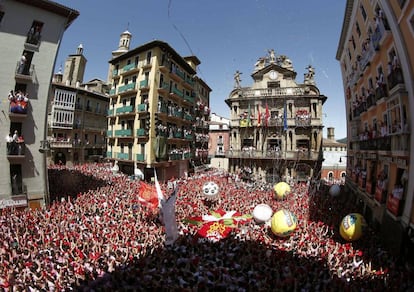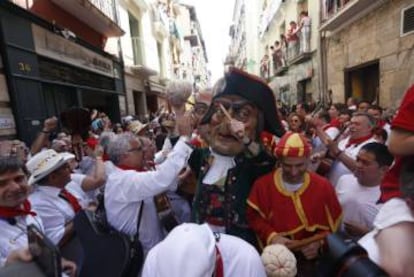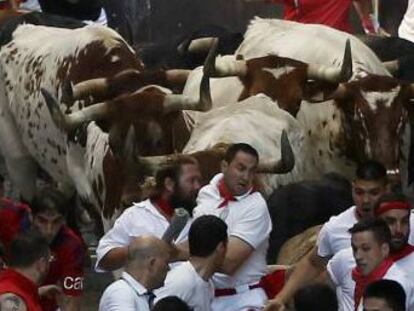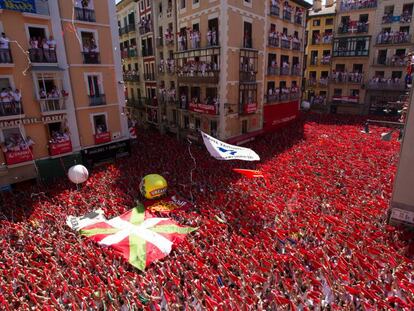Your local, “loco” guide to the festival of San Fermín
An itinerary for rookies and returning runners alike to get the most out of this famous red-and-white orgy

1. Los encierros: the Running of the Bulls
“He who wakes up at six will outrun the bulls. All-seeing Saint Fermín, may God bless you, bless you, bless you!”
Unless a dear friend has one of the exclusive balconies that look out over the streets of Santo Domingo, Mercaderes, or Estafeta (which tourists sometimes rent out for the price of a room at the Ritz), you can be sure that the best, most comfortable way to watch the activities of San Fermín’s Running of the Bulls fiesta is on television. TVE’s channel 1, with the invaluable commentary of Javier Solano, or on elpais.com’s livestream. The alternative? Two hours before (which is to say, at 6am) climb on top of one of the fences around the course, stake out your spot, and be prepared to defend it from aggressive elbows as if you were under siege. Or, of course, watch it all unfold from the inside – the one problem there being that six bulls are running alongside you like six horned trains, ready to stamp your passport to its final destination. Once the encierro finishes – usually after just two or three minutes – it’s just a hop, skip, and jump away to the churrería La Mañueta (8 Mañueta street) – glory be to oil, dough, and sugar.
2. ‘El chupinazo:’ The rocket
Pamploneses, Pamploneses: long live San Fermín! Gora San Fermín!
Chant of the crowd as the ‘Chupinazo’ is fired
Getting up close and personal with the Plaza del Ayuntamiento (main square) at least once in a lifetime is worth the risk. You have to first experience the pure chaos and absurdity of the crowds in order to later curse and swear to yourself: never again, never again, never again. You’ll come out covered in kalimotxo (red wine and soda mix), sangría, cheap sparkling cava, flour and other Unidentifiable Flying Objects now smeared across your body. The celebration begins at noon on the dot with the firing of the chupinazo rocket, and if you want to be there for it, you have two options. One: go down into the plaza around 10am and let the human tide carry you. Two: position yourself in front on one of the entrances to the plaza at 11.45am... and let the tide carry you. You will get in – don’t think about the “how.” Those who are easily prone to picking a fight, or those who are likely to get angry due to the constant raining down of alcohol should abstain.
3. A 9.30am snack
One day, a professional San Fermín festival-goer got an idea. He went with some friends to a tavern in the old quarter of Pamplona and started wolfing down an ajoarriero (a sandwich with cod, garlic, and peppers – one of Hemingway’s favorites) as if there was no tomorrow. He devoured everything in sight, then washed it down with vermouth. When he went off to watch the bullfights, he did so with his stomach gurgling like Krakatoa. After the third bull passed, as tradition dictates, someone handed him a sandwich the size of Burgos Cathedral. “No, no, thank you,” he objected. “Take it, goddamnit!” they insisted. He removed the aluminum foil. And what kind of super-sandwich was it? You guessed it: another ajoarriero. However, these gastronomical over-indulgences usually start even earlier in the morning. In social groups, in basements, in the “txokos” (Basque culinary clubs), in bars... The food consumed on that first day before the chupinazo is impossible to believe if you haven’t experienced it first-hand. Just don’t forget your Alka-seltzer amidst the binging and revelry.
4. The bullfights
No matter what they tell you, at some point in your life you have to see the bullfights at San Fermín. The clashes of ancient Roman gladiators can’t have been very different. Bullfighting purists can’t tolerate the Plaza de Pamplona, which is understandable. But it’s still guaranteed to be packed every day. Latecomers can seek out the scalpers (who are always there, though, of course, it’s expensive). Before the bullfight gets going, a good homemade patxaran (a liqueur common in Basque country) from the bar Monasterio, just a stone’s throw from the plaza, is a must. As you leave, Niza is an excellent choice for the first gin-and-tonic of the day. These instructions aren’t meant to encourage alcoholism, but San Fermín isn’t quite the same with a vanilla milkshake.
He who wakes up at six will outrun the bulls. All-seeing Saint Fermín, may God bless you, bless you, bless you!
5. The music of San Fermín
During the day the festival is full of music, with an infinity of bands and orchestras playing traditional Spanish jotas or bertsolaris that morph into nighttime dance parties called verbenas. The popular sounds and songs pulse through the bars and plazas. At night, in Plaza de los Fueros (from 11pm to 2.30am) you can hear a good selection of current music for all nine days of the party: Duncan Dhu, Fermín Muguruza, Sidonie, Delorean, Asian Dub Foundation, Tonino Carotone, Muchachito Bombo Inferno, and more.
6. San Fermín by day
Pamplona offers daytime parties that are just as exhilarating for whoever wants to escape what we could call the nocturnal globalization of revelry. It’s true that San Fermín at night is like any other party multiplied by a thousand, but what really sets it apart are the daytime celebrations, dominated by parents and children (all sparkling clean in their red and white – which, needless to say, will not be the case with the crowd that follows at night), but also thousands of festival-goers that stick to more traditional sleeping schedules.

To the delight of the children, the streets are filled with roaming puppets called gigantes, large hollow figures with papier mache heads, and cabezudos, human-sized costumes with oversized heads. Meanwhile, older spectators fill the terraces of Plaza del Castillo, Carlos III, Taconera, and the rest of the city, as well as the countless bars of Pamplona for that sacred pre-meal snack. Some recommended areas around San Nicolás and San Gregori, which is the heart and soul of the historic quarter of Pamplones, include Otano, Roch, El Burgalés, Museo, Baserri, El Marrano and Txoko in Plaza del Castillo.
7. Alternatives to the debauchery
For those who want to get a breath of fresh air or stretch their legs (and not just to elbow the person behind them), or even for those who just don’t want to participate in the madness (although in that case it’s better to visit Pamplona at any other time of the year), this city full of history, green spaces, and monuments offers some appealing alternatives. For one, you can follow the city walls from the lovely gardens of Taconera to the impressive Archivo de Navarra. You can also spend the morning or afternoon in Ciudadela park, visiting the Renaissance fort and its walls (10 minutes walk from the old city). The gardens of Media Luna and the campus of the University of Navarra are the perfect spots for a stroll or a quick siesta, far from the hullaballoo. A day-trip will give you the flexibility to visit charming places such as Roncesvalles, the valleys of Ulzama, Roncal, or Baztán, the cities of Puente la Reina and Estella (both along Camino de Santiago) or the Leyre monastery.
8. Eating, drinking, loving, and more
- Food (expensive): Restaurante Rodero, Restaurante Europa, Restaurante Alhambra, and outside of Pamplona (in Zizur Menor, about five kilometers away), Asador Martintxo.
- Food (medium price): Savoy, Zaldiko, Otano, Erretegi on the street Estafeta, La Sidrería de Martintxo.
- Bars with pintxos and small dishes: Bar Gaucho, Bar Txoko and other bars on the streets of San Nicolás y San Gregorio.
- Drinks: Pamplona has endless options, but for watering holes that are truly worth the trip, check out Café Iruña, Bar Savoy, Bar Niza, Bar Kabiya, Bar Burladero, Casino Eslava.
- Love, or sleep: If you’re a modern-day hero and can still find a room at this stage (hint: you can’t), these hotels are worth a look: Expensive (although in San Fermín the price could be three times as much): La Perla, Palacio de Guenduláin, Pamplona Catedral, Tres Reyes; Medium price: Maisonnave, Europa, Yoldi, Leyre; Cheap with a good location: Hotel Eslava.
English version by Allison Light.
Sign up for our newsletter
EL PAÍS English Edition has launched a weekly newsletter. Sign up today to receive a selection of our best stories in your inbox every Saturday morning. For full details about how to subscribe, click here.
Tu suscripción se está usando en otro dispositivo
¿Quieres añadir otro usuario a tu suscripción?
Si continúas leyendo en este dispositivo, no se podrá leer en el otro.
FlechaTu suscripción se está usando en otro dispositivo y solo puedes acceder a EL PAÍS desde un dispositivo a la vez.
Si quieres compartir tu cuenta, cambia tu suscripción a la modalidad Premium, así podrás añadir otro usuario. Cada uno accederá con su propia cuenta de email, lo que os permitirá personalizar vuestra experiencia en EL PAÍS.
En el caso de no saber quién está usando tu cuenta, te recomendamos cambiar tu contraseña aquí.
Si decides continuar compartiendo tu cuenta, este mensaje se mostrará en tu dispositivo y en el de la otra persona que está usando tu cuenta de forma indefinida, afectando a tu experiencia de lectura. Puedes consultar aquí los términos y condiciones de la suscripción digital.










































